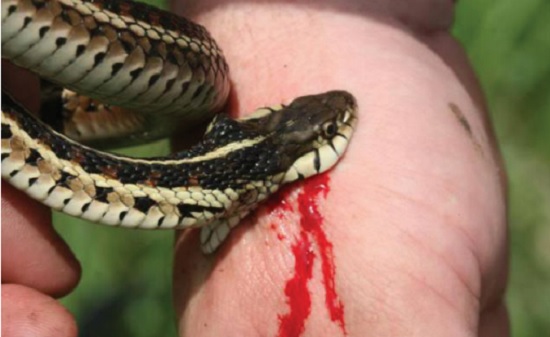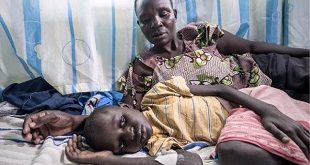
In Uganda, many antivenoms do not work, all snakebite first aid information is wrong
Kampala, Uganda | FLAVIA NASSAKA | In 2002, James Ntulume developed a keen interest in snakes. Then an owner of a farm – Snakes Uganda—located in an upscale Kampala suburb, Muyenga, Ntulume immersed himself into studying the reptiles.
By 2015, he had completed sets of short courses in handling and conserving the reptiles. Last year, he abandoned his full time IT job and officially registered a charity that now offers snake rescue services, sensitization and guides tourists who go deep in forests searching for snakes. Given his reputation, it was only a matter of time that people started reporting to him with festering snakebites.
“Many times people call me that they have been bitten by a snake and do not know what to do,” Ntulume told The Independent, “Others come here. They come weeks or months after failed treatments”.
While at a conference in South Africa, Ntulume was given some antivenom – a chemical that reverse or neutralize the effects of a snakes’ poison. He offers these free of charge.
He told The Independent that the antivenom is manufactured in South Africa and works well for Ugandan snakebites. According to experts, antivenoms work depending on the type of snake that bit you and where it is found. The science of producing antivenom, according to experts, involves extracting venom from snakes and injecting it into animals, such as horses.
The injected animals’ immune systems produce antibodies that neutralize the venom. These can be extracted and stored for later use on human victims who are bitten by that particular snake species.
Currently however, the most popular antivenom in Uganda is from India and, therefore, supposed to treat injuries caused by Indian snakes.
“You just can’t have Indian Antivenom in the hospital. There is a lot of ignorance in treatment here”, said Royjan Taylor an expert from the Kenya based James Ashe Antivenom Trust, an entity set up to help snake bite victims.
Like Uganda, he says Kenya has a number of venomous snakes like the Puff adder, the East African Gaboon viper, Black mamba, the forest cobra and the Egyptian Cobra, among others, which health workers should be aware of in order to offer effective treatments.
“To be able to help, health workers need to know what snake bit a person depending on the symptoms that they show. We are not telling them to go to the jungle and start searching for snakes,” he says,” but they need to know that for some bites you do not need any treatment because it was a dry bite or they are just not poisonous”.
Meanwhile, snakebite envenoming is becoming a major threat. While the World Health Organisation (WHO) had in 2013 removed it from the list of the priority Neglected Tropical Diseases(NTDs), it has now put it back as one of the top 20 diseases claiming many lives especially in the sub-Saharan Africa.
At the World Health Assembly meeting held in May a resolution was passed for the organization to develop a comprehensive plan to support countries in implementing measures for increased access to effective treatment by people who get bitten by venomous snakes.
It is estimated that 2.7million bites happen annually, a fifth of these in Sub- Saharan Africa. Apart from this, a quarter of the world’s 400,000 bite-related fatalities occur in the region. These figures are likely conservative as a few snakebite victims make it to statistic-reporting hospitals.
In fact, figures by an NGO – Health Action International (HAI)—show that 70% of the cases go unreported. At the Ministry of Health, for instance, snakebites are not categorized in the Health Management Information System (HMIS), which captures data collected during provision of health services at health facilities across the country.
It is only now after WHO put it on the list of priority diseases that officials are considering getting a focal point person to cater for issues associated with envenoming.
Betty Nabatte of the Vector Control Division at the ministry says that while the 2016 clinical guidelines give guidance on how to deal with cases, many health workers are not trained on how to deliver treatments.
“The first aid tips they give are wrong,” she told The Independent, “For instance, they tell people to tie the bitten area which is wrong. The black stone that they say sips out the venom is also a lie.” Nabatte added that the ministry is now planning to ensure government procures antivenom through the National Medical Stores (NMS).
Results of the study conducted local NGO – Coalition for Health Promotion and Social Development (HEPs Uganda)— between October last year and March, showed that only 4 percent of the 144 health facilities studied, stock antivenom even as they recorded 593 cases of envenoming within the six months. They also found that in 92% of the facilities, health workers were not trained in delivering treatment.
According to Sophie Von Bernus, a Programme Officer, Snakebite at HAI, that is not the only challenge. The biggest problem with Uganda, she said, is these figures are just estimates. Most of the cases are treated from home or run to traditional healers for help, she explained adding that even though, some would have chosen to go the health facilities; they would be cut off by the high costs of treatment.
Treatment with the Indian antivenom costs up to Shs400, 000 yet the more effective South African vail dose, which is able to treat bites by several snake species in Africa goes for Shs800, 000 in private health facilities. Yet, this does not even include the cost for supportive treatment that complements it. The patient will need other treatment interventions like wound care, pain relief and, in extreme cases, reconstructive surgery because snake venom tends to kill tissue cells whose only treatment is amputating the limb.
There is another catch. The South African brand, which is the best on the market now requires a cold chain and yet the Indian one that doesn’t require that is not effective.
Royjan who is also a self -taught snake handler and snake farm owner, says that while some countries have monovalent antivenoms which treat bites by a specific snake species, the best option for countries like Uganda who have many cases, many snake species and yet with little resources, are the polyvalent antivenoms, which treat a number of snake bites with one antivenom cocktail.
“Research is also ongoing to develop rapid diagnostic tests to quickly identify which kind of snake attacked someone,” Royjan told The Independent, “When this is done, we will be able to provide treatments quickly.”
But before this happens, Royjan says, people should try as much as possible to avoid bites first by changing their attitude of attacking and killing snakes when they spot them. He explains that most of the snakes, even the most poisonous, are peaceful and will not strike unless disturbed.
He recommends that people move away once they spot a snake. If it spits venom in one’s eyes, he adds, they should be rinsed immediately with water. He says once bitten, all tight items on one’s body should be removed and the wounded area left alone. Then, he adds, the patient should also be made to lay on the ground with the side that has not been beaten to limit movement of the affected area.
He warns against lying on the back or use of traditional unsafe treatments. Protecting against bites according to him is as simple as closing all holes in one’s house, cutting grass around the house and watching your steps when in the bush.
For Sophie, however, with comprehensive sensitization, most of the injuries caused by snakes will be avoided.
 The Independent Uganda: You get the Truth we Pay the Price
The Independent Uganda: You get the Truth we Pay the Price



Good evening,
I have developed an interest in joining the champions of snakebite management and I kindly request for information and any other sort of literature about this big challenge in Uganda. I am working on a research proposal for a study. Thank you